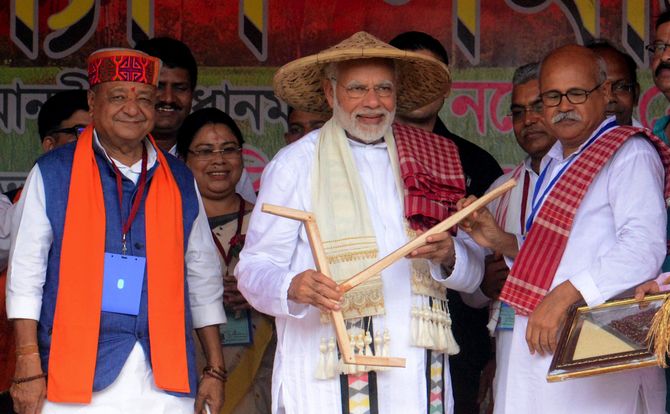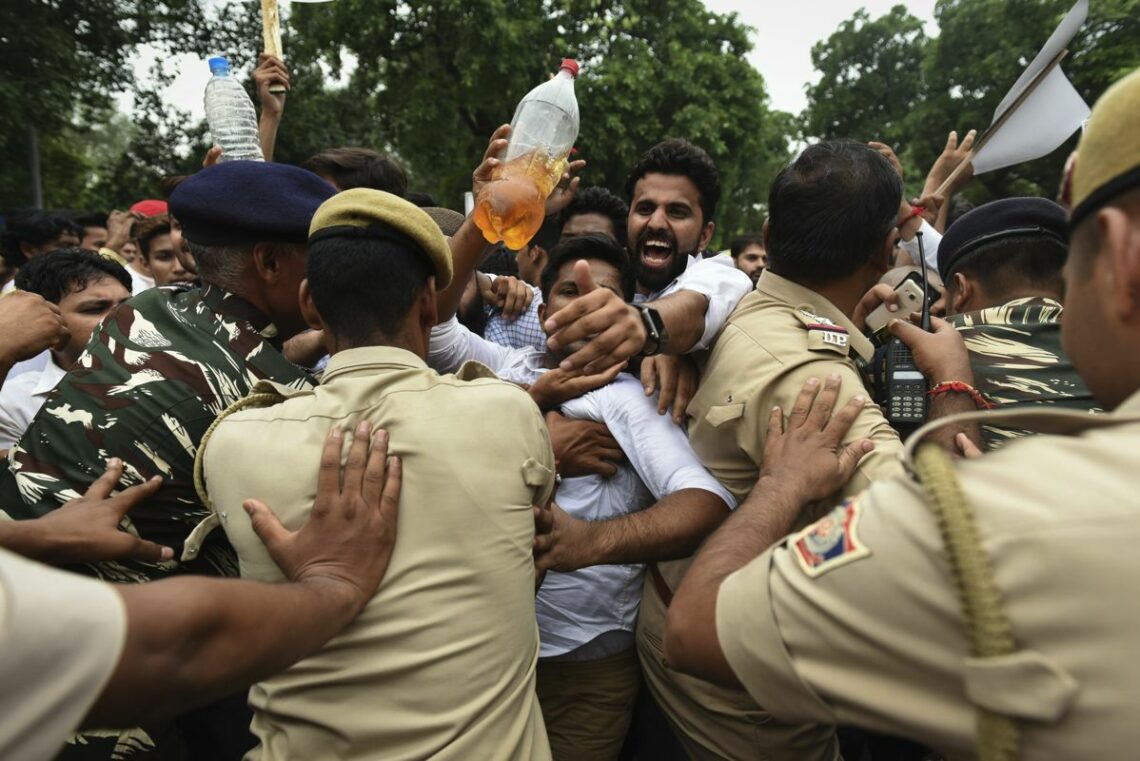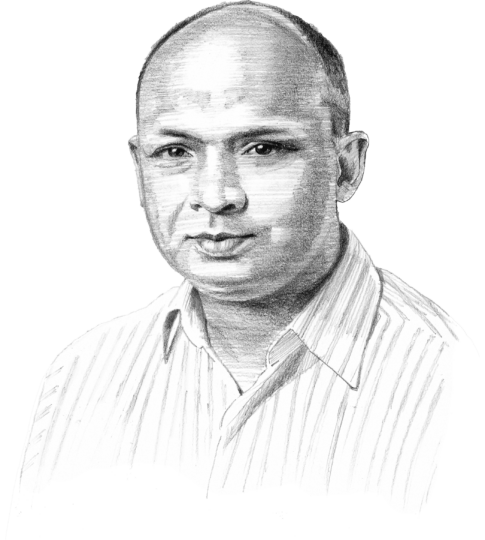2019 Global Outlook: India turns inward
Ahead of the 2019 parliamentary elections, Prime Minister of India Modi has put aside his earlier economic reforms and talks mostly about social welfare. While the leader focuses on small-town voters, his government has put foreign policy initiatives on hold.

In a nutshell
- Facing general elections, Prime Minister Modi is emphasizing social welfare
- Provided he limits the ruling BJP’s losses, Mr. Modi will resume economic reforms
- As domestic issues preoccupy the government, foreign policy will be more passive
The Narendra Modi government began 2018 satisfied it had carried out major corrective surgery on the Indian economy. Its concern was that the patient’s recovery was proving slower than expected. More worrying for the Indian prime minister was that the economic pain he had inflicted might continue into his reelection campaign. India’s next national elections must be held by May 2019.
Economic growth had accelerated gently to just over 7 percent. Yet the bald statistics hid weak job growth, flagging private investment, judicial and administrative resistance to Mr. Modi’s more radical reforms, and a stubborn bad loan issue in the banking sector.
Local elections in December saw the defeat of three state governments ruled by Mr. Modi’s Bharatiya Janata Party (BJP). While mainly fought over local issues, the results were partly attributable to the ruling party’s eroded popularity.
Modi rebooted
Recognizing this early on, Mr. Modi spent the past year reinventing himself. While his first few years in office were all about shrinking the sizeable informal sector of the economy and making the country more business-friendly, the past year has seen the Indian leader talk mostly about social welfare.
During his August 15 Independence Day speech, the prime minister announced a new universal healthcare program. Somewhat at variance with the nativist conservative ideology of the BJP, he spoke of “ensuring justice for the poor” and how “social systems” should not get in the way of middle-class dreams.
His government’s utterances and budget commitments throughout the past year have stressed healthcare, as well as earlier programs such as low-income housing, rural electrification, sanitation and cooking gas connectivity. In effect, the prime minister sought to compensate for disaffection among urban voters and business groups, disoriented by the economic disruptions of earlier reforms, with an appeal to rural voters and poorer segments of the population. Mr. Modi’s rhetoric about the opposition has become more personal and pugnacious in recent months, a sign he is wooing small-town rather than metropolitan India.
The BJP lost as much as 8 percent of its support in some state elections – lethal numbers in Indian politics.
Anticipating that domestic politics would overwhelm the rest of its agenda as the 2019 general election approaches, the government spent much of 2018 putting its foreign policy on hold. In April, Mr. Modi and Chinese leader Xi Jinping agreed to ease bilateral tensions after several years of confrontation. Defense cooperation with the United States continued to strengthen, but overt geopolitical realignments were set aside. As part of a campaign to calm regional waters, Mr. Modi attended the inauguration of the new Maldivian leader, symbolically welcomed the election of a new Pakistani prime minister, and even shook hands with the new pro-Chinese regime in Nepal.
Electoral omens
Prime Minister Modi enters this election year with mixed indications from the local polls. The BJP has lost as much as 8 percent of its previous support in some state elections – lethal numbers in India’s competitive politics. His personal approval ratings remain consistently north of 60 percent. That is necessarily decisive in India’s Westminister-style parliamentary system since his name will appear only in the constituencies he personally contests. The overwhelming majority of Indian voters will see just the BJP’s lotus symbol on their ballots.
Mr. Modi will campaign through the first quarter to make the upcoming parliamentary elections (due in late April or May) about national rather than local issues. He will urge Indians to think of him rather than the BJP when they enter the voting booth. The government will also maneuver, by hook or by crook, to keep the opposition splintered.
Half a dozen preliminary polls over the past few months indicate a BJP-led coalition would still win. All show the BJP losing its absolute majority. The party’s exact tally will determine the character of the new Indian government.
Three scenarios
If Mr. Modi can limit the ruling party’s losses to 30 or 40 seats in the general election, his executive power will be only marginally reduced. The polls show this to be the most likely electoral scenario. His coalition partners will be fobbed off with a few loaves and fishes of office. Modi would then initiate new reforms, this time focused on changing India’s governance structure.
The current push to hand over more economic authority to the state governments will accelerate if the prime minister wins a second term. He will weaken the permanent bureaucracy and try to open it up to outside talent. New moves will be made to overhaul India’s decrepit judicial system. Some fundamental market-friendly reforms mooted in 2014-15 will be put back on the agenda, including streamlining the corporate tax structure and aggressive privatization.

If the BJP’s losses grow to 70-80 seats, as the main opposition Congress Party believes will happen, the BJP will be forced into a “normal” Indian coalition government: unfocused and unwieldy. It will still be possible to legislate, but not to make major changes. The prime minister will have to work through the system rather than against it. As a result, Mr. Modi’s agenda would be restricted to implementing what has already been enacted. His cabinet’s survival would be held hostage to large regional parties, which could always force an early election if the government stumbles badly enough. The opposition’s primary goal would be to cut the prime minister’s larger-than-life image down to size.
Several possibilities arise if the ruling coalition’s losses exceed 100 seats. Mr. Modi will be adjudged to have lost his mandate even if the BJP remains the largest party. One consequence could be an internal party revolt led by the BJP’s old guard. Another party leader – most likely Nitin Gadkari, who currently heads the transportation ministry – would take over as prime minister.
The BJP might even decide to go over to the opposition, allowing a weak coalition of regional parties to rule, then join others in bringing the government down once it makes enough policy mistakes. Such independent cabinets rarely last more than two years, but often pave the way for a BJP or Congress party comeback. Under this scenario, Mr. Modi would still be a strong candidate for the premiership.
Policy outcomes
The next Indian government will face tricky economic problems. One will be unfavorable international headwinds as tightening monetary policies and trade tensions slow down global growth. The other will be how to settle the overhang of bad debts that continue to bedevil the banking and financial sector. A left-of-center regime is more likely to go for a government-backed bailout while ignoring the administrative reforms needed to prevent a recurrence.
India will try to leverage the Sino-American conflict to wring concessions from both countries.
One encouraging sign is that private investment is starting to recover. If that picks up significantly, the losses on the external side would be negated and the present 7 percent pace of economic expansion could be maintained. Most forecasts, including those by the International Monetary Fund and Moody’s, put India’s 2019 growth rate on par with 2018.
India’s foreign policy will remain relatively passive this year. New Delhi understands its present truce with Beijing arises from the latter’s problems with Washington. But India also believes the Trump administration will drift into paralysis as it is consumed by congressional investigations and weakened by a U.S. economic downturn.
Based on this analysis, India will try to leverage concessions from both countries. New Delhi will increase its demands on Washington to make available more advanced defense technology. From Beijing, it has already secured minor market-access concessions. China will also be pressured to place further restraints on Pakistani belligerence toward India.
More action may occur with second-tier friends like Japan or the United Arab Emirates. The inward look that Indian politics acquired in 2018 will carry over to 2019. No matter what government takes office, it will not enjoy the groundswell of support that swept Mr. Modi into power five years ago.








